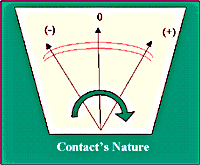Adjustment to the Environment
A tool for accelerated product evolution
First published in hebrew in "Status -
management thinking magazine", issue 98, August 1999.
Authors:
Ari Manor, CEO, ZOOZ (former CEO of SIT), and Idit Biton, Marketing
manager, SIT.
Part II
D. A Thinking Tool for Systematic Innovation
The SIT method for new product development consists of 6 different thinking tools that facilitate product modification. One of these thinking tools, called Adjustment to the Environment, is presented in this article.
Adjustment to the Environment, as the name suggests, is a thinking tool that examines the interactive nature between the product and its relevant environment, and offers ways to improve this interaction. The examination is systematic and follows these three steps:
1. List the elements of the product's
environment
2. Examine the
interactive nature between the product and each of the listed elements in its environment
3.
Suggest ways for improving
the interaction
Here is a more detailed description of the three steps:
1. List the elements of the product's environment
- What interacts with the product?
2. Examine the interactive nature between the product and each of the listed elements in its environment
- Is the interactive nature harmful, neutral, or beneficial (in your opinion)?
3. Suggest ways to improve the interaction
- If harmful - how can the damage be minimized? Eliminated? Reversed?
- If neutral - how can it be made beneficial?
- If beneficial - has it been advertized?
Here is a short example with a loudspeaker.
Fig. 3: Loudspeakers
1. List the elements of the product's environment
- What interacts with loudspeakers?
- Floor, shelves, cupboard, rug, wall, receiver, ear (the interaction does not have to be physical and direct), eye, sun, dog, child, book (placed on the speaker), plant, etc.
2. Examine the interactive nature between the product and each of the listed elements in its environment
- Would you describe the interaction as harmful, neutral, or beneficial?
A. The interaction with the dog
is harmful - the speaker makes some high pitched sounds that are not within human hearing range, yet are bothersome and irritating for dogs.
B. The interaction with the ear is neutral - the loudspeaker does not rotate according to the location of the ear.
C. The interaction with the plant plants grow better when exposed to classical music.
3. Suggest ways for improving the interaction
- If harmful -- how can the damage be minimized? Eliminated? Reversed?
- If neutral - how can it be made beneficial?
- If beneficial - has it been advertized?
A. A speaker that is restricted to sounds within the human hearing range and thus
is not bothersome to dogs.
B. A speaker that responds to the position of the ear (e.g. rotates to adjust itself to the position of the
ear or the nearby remote control).
C. Advertise and market special speakers for greenhouses and/or garden terraces.

Fig. 4: Rotating loudspeakers
E. Adjusting a PC Mouse to a Table
Here is a more detailed example regarding a PC mouse product.
1. Environment elements - what interacts with the mouse?
- Some of the elements are: mouse pad, table, user's hand, computer cord and plug.
2. The nature of the interaction - harmful, neutral, beneficial?
- For methodological reasons, we will focus here only on the interactive nature between the mouse and the table .
- The interactive nature may be marked using the following symbols:
|
|
|
|
|
|
|
|
|
- Our objective is to try to turn an interaction from negative to neutral, and from neutral to positive. We can imagine this as moving a dial on a scale:

Fig. 5: Improving the nature of the interaction
- Defining an interaction as positive, neutral or negative depends on the interpretation. There is no "right" or "wrong" interpretation.
In this example, the interactive nature can be interpreted all three ways:
a) Negative interaction - the dust on the table may cause the mouse to malfunction.
b) Neutral contact - the mouse does not scratch or damage the table surface.
c) Positive contact -
the table supports the mouse, providing the friction needed for the mouse ball to rotate, changing the cursor's position on the monitor screen accordingly.
- No matter how we define the interactive nature, we must be consistent and continue to the third step of this thinking tool for each given interpretation.
3. Ways for improving the interaction between the mouse and the
table
A. A dust resistant mouse
(not impaired by dust)
- This idea turns a negative interaction (harmful dust) into a neutral interaction (the dust does not harm the mouse)
- Once the idea is suggested, we must find a technology that enables it, and evaluate its cost. In this case, we can think about brushes on the mouse that keep the dust away, or prevent contact between the dust and the mouse ball
- Next, we have to examine the benefits of a dust resistant mouse. For example - reliability, fewer failures, fewer mistakes, and less frustration at work
B. A table-cleaning mouse
- This idea turns a neutral interaction (the mouse does not damage the table) into a positive interaction (the mouse cleans the table)
- Brushes on the mouse combined with an appropriate dust container (on the mouse) may remove the dust off the table, providing a proper technological solution
- Now we should examine the benefits for such a product. For example - perhaps
the mouse's reliability increases and the failure rate decreases even further,
or perhaps such a mouse is needed for relatively dirty work environments (e.g. -
for garages, or for laptops used outdoors)
C. The table supports the mouse, and provides friction for the mouse ball. Here the interaction is already positive, and there are two possible paths for innovation:
First path: improve the interaction even further
- For example - since the normal interaction with the table is beneficial, an abrasive table or mouse pad may move the mouse ball even better
- In this case we as mouse manufacturers probably do not posses the technology needed for the suggested improvement, since we do not produce mouse pads or tables. Hence, our path to improvement is blocked
Second path: advertise an already existing promise (benefit)
- If the benefit was not advertised before, is not trivial to the users, and is meaningful, it can be used for positioning the product (even if competing products share the same benefit)
- In this case, everybody knows that the table provides friction for the mouse ball. It is a trivial benefit, and therefore the path of advertising it is blocked as well
- Advertising an existing promise without changing the product at all has many advantages when applicable. Read more about this in the final part of this article
To read the final part of this article - continue





